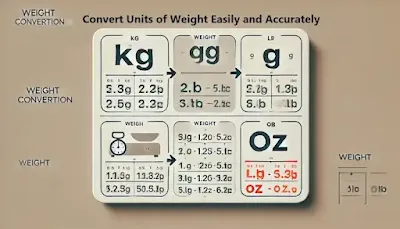Weight Converter Tool
How to use the tool
To use the weight conversion tool on the linked Arabic website, follow these simple steps:
1- Select the Units: Choose the weight units you want to convert from and to (e.g., from kilograms to pounds).
2- Enter the Value: Input the weight value in the designated field (e.g., 5 kilograms).
3- Click Convert: Press the conversion button to get the result in the target unit instantly.
4- View the Result: The converted weight will appear on the screen, showing the equivalent in the unit you've chosen.
This tool simplifies weight conversion and is ideal for quick and accurate results.
Introduction to Weight Conversion
Weight conversion becomes an essential skill for many daily tasks. Whether you’re cooking, working out, or traveling, understanding how to convert weight accurately can make life simpler and more efficient. For instance, a recipe from the UK might list ingredients in grams, while a recipe from the US might use ounces or pounds. Similarly, fitness enthusiasts often encounter weights measured in kilograms but may need to track their progress in pounds.
Mastering weight conversion doesn’t just save time—it enhances accuracy and ensures that measurements align with specific regional practices. With various units in use globally, knowing how to convert weights manually or with tools can bridge the gap in different fields.
Key Units of Weight and Their Uses
Several weight units are commonly used around the world. Understanding the most prominent units will help us make accurate conversions.
- Kilogram (kg): As the primary unit of mass in the metric system, the kilogram is widely recognized in scientific, commercial, and everyday contexts. It is the base unit of weight in most countries and is commonly used for medium to large measurements.
- Gram (g): A smaller unit than the kilogram, the gram is ideal for precise measurements and is often used in cooking, pharmaceuticals, and other fields requiring accuracy.
- Pound (lb): The pound is an imperial unit widely used in the United States and sometimes in the UK. It is often used in body weight measurements and various domestic applications, including food packaging.
- Ounce (oz): The ounce is another imperial unit, usually applied to smaller quantities, such as food ingredients or small weights in industries. The ounce is commonly seen in recipes, making it essential to know when converting for cooking.
- Metric vs. Imperial Systems:
- Metric: Standardized globally, with units such as grams, kilograms, and tonnes.
- Imperial: Used mainly in the US, with units like pounds and ounces.
Popular Weight Conversion Formulas
Converting between these units often requires straightforward multiplication or division. Here are some of the most common conversions and formulas:
Kilograms to Pounds (and Vice Versa)
Formula: 1 kg ≈ 2.20462 lbs
To convert kilograms to pounds, multiply the number of kilograms by 2.20462.
Example: 5 kg = 5 * 2.20462 ≈ 11.0231 lbs
Conversely, to convert pounds to kilograms, divide by 2.20462.
Grams to Ounces (and Vice Versa)
Formula: 1 g ≈ 0.035274 oz
To convert grams to ounces, multiply the grams by 0.035274.
Example: 200 g = 200 * 0.035274 ≈ 7.0548 oz
For ounces to grams, divide by 0.035274.
Pounds to Ounces (and Vice Versa)
Formula: 1 lb = 16 oz
This conversion is simpler, as it’s a direct multiplication or division.
Example: 3 lbs = 3 * 16 = 48 oz
To convert ounces to pounds, divide by 16.
By familiarizing yourself with these formulas, you can perform quick conversions with accuracy. Decimal precision might be crucial for certain applications, so always consider rounding based on the context.
Common Tools and Resources for Weight Conversion
While manual conversion is useful, tools make the process faster and more efficient. Here are some recommended options:
Conversion Charts: Printable or digital charts can be extremely helpful, especially in the kitchen or workplace. They provide direct conversions and eliminate guesswork.
Mobile Apps and Online Calculators: Apps like MyFitnessPal or online calculators offer accurate, on-the-go conversions. Simply input the number, select units, and the tool will calculate instantly.
Digital Scales with Conversion Functions: Some scales have built-in conversion settings, allowing you to switch between units effortlessly.
Each tool has unique advantages, and digital options are excellent for quick, error-free conversions.
Weight Conversion in Real-Life Applications
Cooking: Recipes often differ in units based on origin. A UK recipe might list ingredients in grams, while a US recipe could use ounces. Knowing how to convert allows for consistent results without impacting taste or texture.
- Fitness: In fitness, weights are frequently measured in kilograms in some countries and in pounds in others. Knowing the conversion makes it easier to track progress accurately and understand weight standards at the gym.
- Travel: Luggage weight limits vary based on airlines, often expressed in kilograms internationally but in pounds in the US. Being able to convert ensures you stay within weight limits and avoid fees.
- Weight conversion isn’t just a technical skill—it’s practical knowledge that simplifies interactions across cultures and industries.
Tips for Accurate Weight Conversion
Achieving precise weight conversions requires attention to detail and the right tools. Here are some essential tips:
- Use Reliable Tools: Whether digital or manual, ensure the conversion tools or formulas you use are accurate.
- Check the Measurement’s Context: For scientific or nutritional purposes, rounding to the nearest decimal may be crucial.
- Avoid Estimation in Critical Cases: For cooking or medication, estimating conversions can lead to unwanted results. Precision is key for effective conversions in sensitive contexts.
These tips ensure that conversions are reliable and reduce errors that could affect outcomes in practical scenarios.
Conclusion
Weight conversion is a valuable skill. By understanding different units, using reliable conversion formulas, and applying these in practical situations, you can achieve accurate results effortlessly. Embrace tools like apps, calculators, and charts to enhance precision and make your conversions quick and efficient. Whether for cooking, travel, or fitness, mastering weight conversion adds convenience to daily life.
